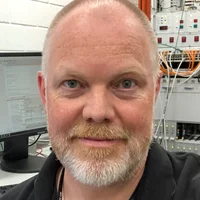Raw data provided by neutron area detectors (i.e. CCD, CMOS camera systems, Imaging plates, ...) is mostly stored as individual data files in FITS format or optionally as 16bit grayscale TIFF image data. This data has to be converted into corrected radiographic transmission images by subtracting a CCD camera dark current offset, and then dividing by flatfield images accounting for the spatial variation of the illuminating neutron beam and scintillator in-homogeneity. In the same step neutron exposure normalization for a series of images has to be performed by deriving a scaling factor in an open beam region of interest i.e. a small image area besides the object under investigation. In this way temporal variations in the neutron source intensity are taken into account.
A standard open software tool for this kind of image arithmetics is ImageJ. For reliable quantification additional backgrounds originating from neutron scattering in the sample or some kind of detector / sample environment backscattering have to be considered. An IDL virtual machine IDL VM based software tool QNI can be used for this purpose.
3D volume data from neutron tomography acquisitions is provided as object slices perpendicular to the rotation axis. The slice images are obtained by tomography reconstruction i.e. applying inverse Radon transform to projection data (i.e. the negative logarithm of corrected radiographic transmissions). The 3D volume data can be visualized using special 3D rendering software e.g. VGStudio.
The result of processed radiography data are transmission values i.e. floating point values in the range [0-1], whereas for tomography acquisitions the reconstructed slices contain linear attenuation coefficient values in some inverse length scale. To derive quantitative information from this, the validity of the exponential law of radiation attenuation (aka Beer-Lambert law) is assumed. Thereby material composition e.g. a humidity content can be calculated.
3D volume data from neutron tomography acquisitions is provided as object slices perpendicular to the rotation axis. The slice images are obtained by tomography reconstruction i.e. applying inverse Radon transform to projection data (i.e. the negative logarithm of corrected radiographic transmissions). The 3D volume data can be visualized using special 3D rendering software e.g. VGStudio.
The result of processed radiography data are transmission values i.e. floating point values in the range [0-1], whereas for tomography acquisitions the reconstructed slices contain linear attenuation coefficient values in some inverse length scale. To derive quantitative information from this, the validity of the exponential law of radiation attenuation (aka Beer-Lambert law) is assumed. Thereby material composition e.g. a humidity content can be calculated.
$\begin{aligned}
T_w&=\frac{I_w}{I_{ow}}=e^{-\Sigma_w t_w+\Sigma_d t_d} & & T_w:&&wet&state\\
T_d&=\frac{I_d}{I_{od}}=e^{-\Sigma_d t_d} & & T_d:&&dry&state\\
\frac{T_w}{T_d}&=e^{-\Sigma_w t_w} \Rightarrow -ln(\frac{T_w}{T_d}) = \Sigma_w t_w\\
\end{aligned}$
with known Σw and pixel size ps the volume of the wet phase per pixel can be calculated: Vw = tw * ps2
with known Σw and pixel size ps the volume of the wet phase per pixel can be calculated: Vw = tw * ps2
